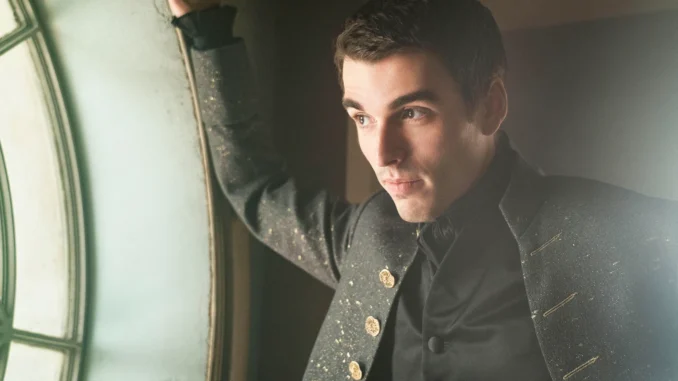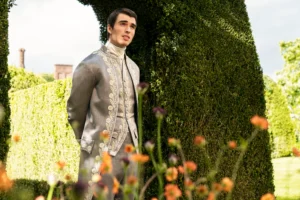
The King of England’s mysterious illness baffled historians for years.
Bridgerton series Queen Charlotte delved into a brand new romance, though this time it didn’t feature one of the Bridgerton siblings. Instead, the spin-off focused on a younger version of King George III and Queen Charlotte, whose older counterparts appeared in supporting roles in Bridgerton seasons 1 and 2.
Played by newcomer Corey Mylchreest and India Amarteifio, the couple faces a fair share of challenges, including dealing with the king’s ailment and deteriorating health.
While the Netflix series takes some creative liberties with its fictional portrayal of the real royals, the story is based on true events.
So, if you’re wondering what illness King George suffered from in real life, read on for everything you need to know from his beginnings to the illness that plagued him and Queen Charlotte.
Queen Charlotte: A Bridgerton Story – King George’s illness explained
George suffered several bouts of severe mental illness during his reign. On one occasion in 1778, he was restrained with a straitjacket after becoming aggressive. On another occasion, he began foaming at the mouth and speaking incoherently for hours on end. At one point, rumours surfaced that he’d tried to shake hands with a tree after mistaking it for the King of Prussia, thereby earning the nickname ‘The Mad King’.

While George had always previously managed to recover from these spells, his final mental health episode, said to be brought on by the passing of his favourite daughter Princess Amelia, lasted a full decade until his death. The royal also suffered from rheumatism and lost his sight and hearing during his final years, which were spent in seclusion at Windsor Castle. He eventually died at the age of 81 in 1820 from pneumonia and was succeeded by sons George IV and William IV.
There’s still debate about what caused George’s mental health woes. Some believe he was bipolar, while others claimed he had the genetic metabolic disorder known as porphyria.
A 2005 hair analysis sample detected high levels of arsenic poisoning, suggesting his medication may have led to his deterioration also.
Bridgerton occasionally alluded to George’s condition in its first two seasons, such as the scene in which the royal believed he was getting married when it was Edwina Sharma who was tying the knot. However, it is a core focus in the prequel spin-off.
Who was Dr Monro, who treated King George?
After being diagnosed with everything from an “inflamed cerebellum” to “excess of ill humour in the legs” by various medics, the fictionalised version of George III is told that he’s “merely suffering a disorganisation of the nerves” by Dr Monro (Guy Henry).
The doctor then subjects his patient to several extreme forms of treatment, including bounding him to a leech-covered chair and nearly drowning him on multiple occasions in an ice bath, explicitly referring to George as an “animal in a cage”.
There was a Monro in real life – one named Thomas – although Queen Charlotte reportedly made sure that his duties were restricted to passive observing. The doctor later resigned from his Principal Physician post at psychiatric hospital Bedlam, following accusations he’d acted inhumanely towards the patients he was treating.
Who was King George III?
George was baptised on the same day he came into the world at London’s Norfolk House in 1738. Born two months prematurely, he wasn’t expected to survive beyond his first night. But the resilient royal made a miraculous recovery, growing up to be a smart but introverted child.
By the time he reached eight years old, he could already engage in the political discourse and communicate in his English father Frederick and German mother Augusta’s native tongues.
In 1751, the former suffered a fatal lung injury, leaving George next in line to the throne. He was crowned the Prince of Wales soon after and aged 18 was offered his own palace, turning it down to stay at home with his strict mother. George ascended to the throne four years later when his namesake grandfather George II passed away.
King George III’s family
Following a failed romance with Lady Sarah Lennox and a failed attempt to marry him off to Princess Sophie Caroline of Brunswick-Wolfenbüttel, George found ‘the one’ in Princess Charlotte of Mecklenburg-Strelitz. The pair married in 1761 on the same day the latter moved from her German hometown to London.
Unlike most of his male relatives, George was a dedicated family man who remained with Charlotte until his death. The royals had 15 children in total, although two sadly died in infancy, and had three residencies to choose from: Kew Palace, Windsor Castle, and Buckingham Palace.
George was reportedly quite the disciplinarian, though. He demanded that all his kids begin their education at 7am each morning and was often left deeply frustrated when they made mistakes as adults, none more so on learning of his sons’ extra-marital affairs.
King George III’s reign
Having sat on the throne from 1760 until his death in 1820, George was the longest-reigning monarch in British history until his granddaughter Queen Victoria surpassed his tally by three years. His period in power was a particularly turbulent one too.
He became King at the height of the Seven Years’ War, a global conflict in which the British successfully fought the French to become Europe’s ultimate superpower. Another major triumph was the battle against Napoleonic France, which was eventually settled by the defeat of the diminutive dictator at the Battle of Waterloo.
Less successful was his role in the American War of Independence, in which all 13 British colonies were lost.
Having previously described the act of slavery as repugnant in an essay penned during his teenage years, George also later signed the act which abolished the slave trade in the British Empire. His attentiveness to political matters often frustrated government ministers, while his interest in the British Agricultural Revolution earned him the derisory nickname ‘Farmer George’.
